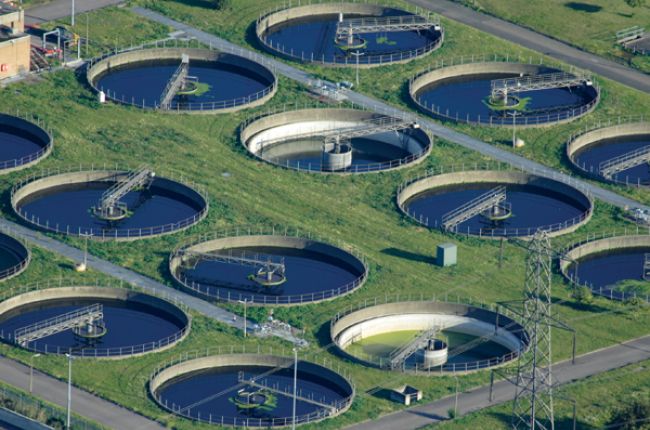Affordable Solutions for Large-Scale Waste Water Treatment Facilities
Affordable Solutions for Large-Scale Waste Water Treatment Facilities
Blog Article
Strategic Approaches to Improve Waste Water Therapy Efficiency and Lessen Ecological Influence
In the world of waste water treatment, the mission for enhanced efficiency and lowered environmental influence is a continuous difficulty that demands calculated services. The assimilation of innovative therapy innovations, energy-efficient processes, resource recovery approaches, improved nutrient removal techniques, and clever tracking and control systems represents a diverse structure for addressing these pushing issues.
Advanced Treatment Technologies
Innovative membrane layer filtration systems have actually reinvented innovative wastewater therapy processes, considerably improving the removal of contaminants. These innovative systems operate forcibly water with a semi-permeable membrane, properly separating impurities from the water stream. The membrane's tiny pores catch contaminants such as bacteria, infections, and put on hold solids, permitting only purified water to pass through. This technology has actually confirmed to be extremely effective in removing a variety of contaminants, consisting of drugs, heavy steels, and natural substances, which are typically challenging to eliminate through standard therapy techniques.
Furthermore, membrane layer filtering systems use various benefits over standard treatment strategies. They call for less space, produce higher-quality effluent, and are much more resistant to variations in influent water top quality. Furthermore, these systems are very flexible and can be conveniently integrated into existing treatment plants or used as standalone devices for decentralized applications. As the need for clean water remains to rise, the adoption of advanced membrane layer purification modern technologies is vital to make sure sustainable and efficient wastewater treatment techniques.
Energy-Efficient Procedures
The combination of energy-efficient processes in wastewater treatment systems is vital for enhancing source utilization and lowering functional prices. One key approach to improving power efficiency in wastewater therapy is the usage of innovative aeration systems, such as great bubble diffusers or surface area aerators, which can enhance oxygen transfer efficiency and lower power intake.
Moreover, maximizing procedure control and automation through making use of sophisticated sensors and checking systems can improve general power effectiveness by changing operations in real-time based on real demand and conditions. Executing energy audits and consistently keeping an eye on energy efficiency indicators are crucial techniques to identify locations for renovation and track energy-saving campaigns effectively. In general, the fostering of energy-efficient processes in wastewater therapy not only benefits the setting yet additionally adds to lasting cost financial savings and operational sustainability.
Source Recovery Strategies
With an emphasis on maximizing source application and sustainability in wastewater therapy systems, the implementation of resource recovery methods arises as an essential element in enhancing functional performance. Resource healing approaches in wastewater therapy entail the recognition and removal of valuable resources from the waste stream, thereby transforming what was when considered waste right into a useful property. By implementing resource healing strategies such as nutrient elimination and recuperation, power generation from raw material, and the production of multiple-use water, wastewater treatment plants can minimize environmental influence while taking full advantage of performance.

Boosted Nutrient Elimination Methods
Carrying out sophisticated nutrient elimination strategies is crucial for maximizing the performance of wastewater therapy systems. Improved nutrient removal plays a vital function in decreasing the ecological effect of treated effluent discharged right into water bodies. Among the crucial methods utilized for enhanced nutrient removal is the process of organic nutrient removal (BNR), which entails the elimination of nitrogen and phosphorus through organic processes. This can be achieved via the use of specialized microbes that can transform nitrogen compounds right into inert nitrogen gas via denitrification, and accumulate phosphorus within their cells with a procedure called enhanced organic phosphorus removal (EBPR)

Along with BNR, progressed treatment approaches such as membrane bioreactors (MBRs) and created marshes can also be utilized to enhance nutrient removal efficiency. MBRs make use of membrane layers to accomplish high-quality effluent requirements by properly removing nutrients and suspended solids. Built wetlands simulate all-natural marsh processes to remove nutrients with plant uptake, microbial task, and sedimentation. By integrating these innovative nutrient removal techniques into wastewater treatment systems, markets and towns can effectively reduce nutrient pollution and shield the environment.
Smart Surveillance and Control Solution
Utilizing sophisticated modern technology, the combination of smart monitoring and control systems revolutionizes the read review functional effectiveness of wastewater therapy centers. These systems integrate advanced sensing units and data analytics to continuously keep an eye on crucial parameters such as pH degrees, turbidity, dissolved oxygen, and circulation rates in real-time. By collecting and analyzing this information, operators can obtain useful insights right into the performance of the therapy processes, making it possible for positive adjustments to enhance treatment efficiency.
Smart monitoring and control systems additionally support remote tracking capabilities, enabling operators to gain access to real-time information and control functions from off-site areas. This remote ease of access enhances functional adaptability and responsiveness, allowing swift treatments in instance of system malfunctions or variations in influent high quality. The predictive upkeep capabilities of these systems aid prevent devices failings and decrease downtime, ultimately improving the general integrity of wastewater therapy operations.
Conclusion
In final thought, critical methods such as sophisticated therapy modern technologies, energy-efficient processes, resource healing techniques, boosted nutrient elimination techniques, and wise surveillance and control systems play an essential function in boosting wastewater therapy performance and decreasing ecological influence. By carrying out these techniques, wastewater treatment plants can improve their overall performance, reduce power usage, recuperate valuable sources, and ensure conformity with environmental policies. These techniques are crucial for lasting and reliable wastewater administration methods.

In final thought, strategic strategies such as advanced therapy technologies, energy-efficient procedures, source healing techniques, boosted nutrient elimination techniques, and clever monitoring and control systems play a critical duty in improving wastewater therapy try this web-site efficiency and lessening ecological impact.
Report this page